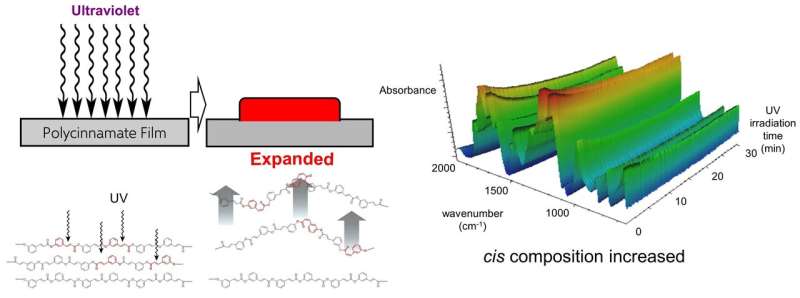Photoexpansion: Bio-based polyesters hard film

Polymers that exhibit their functions by light have been studied for a few decades because they enable device miniaturization, energy saving, and precise signal control. Polymers based on azobenzene, diarylethene, etc. are the pioneers, and many examples of light-driven motors and artificial muscles have been reported. On the other hand, cinnamic acid, which is a constituent of lignin in natural wood, also exhibit the function by ultraviolet (UV) rays, so that it has been applied to polymers. The deformation mechanism of these cinnamate-based polymers has not been clarified because the two reactions of double bond cis-trans isomerization and [2+2] cycloaddition occur almost simultaneously. Since the mechanism has not been clarified, its use as a photodeformable material has not received as much attention as the above-mentioned azobenzene and diarylethene.
To tackle these issues, a team of researchers from Japan Advanced Institute of Science and Technology (JAIST) are investigating photobending mechanism of bio-based polycinnamete films. Their latest study, published in ACS Applied Materials & Interfaces, was led by Professor Tatsuo Kaneko and Assistant Professor Kenji Takada also involved Professor Hideyuki Murata, Associate Professor Kosuke Okeyoshi, and Research Assistant Professor Amit Kumar.
In this study, polyesters were synthesized based on coumarates in which hydroxyl groups were substituted in the aromatics of cinnamate. Among them, those showing photodeformability were poly(3-hydroxycinnamic acid) (P3HCA) and poly(3,4-dihydroxycinnamic acid) (PdHCA). Although both films had a cinnamate unit, P3HCA showed convex deformation with respect to an UV source, and PdHCA showed concave deformation, respectively. These differences were analyzed by various spectral analyzes. First, when the fluorescence lifetime was measured, it was found that there are two excited states in P3HCA. Next, by time-resolved infrared (IR) spectroscopic measurement, the absorption of the double bond of the cinnamate unit was traced from the change in the IR spectrum during UV irradiation.
In the case of P3HCA, it was confirmed that the absorption of cis-formed -CH=CH- bond was increased by increasing the UV irradiation time. On the other hand, in PdHCA, no change in the absorption of cis-formed -CH=CH- was confirmed. To prove these photoexpansions, an experiment was conducted in which a P3HCA film was covered with a photomask and UV rays were irradiated from above. When the free-standing film was irradiated with UV through a photomask, the non-irradiated surface also showed a deformation. Therefore, when an irradiation experiment was conducted with the P3HCA film coated on the glass substrate, there was no deformation of the surface, opposite side, not irradiated with UV, and no deformation of the part covered with the photomask was observed. From the above results, it was found that P3HCA exhibits convex deformation by expanding with respect to UV owing to cis isomerization.
There is no other example that is bio-based and can control the deformation with respect to UV light. In addition, by elucidating the deformation mechanism of polycinnamates through this research, precise control of photodeformability based on a dense polymer design can be expected. The fact that the photodeformability differs depending on the shape of the molecule, as Prof. Kaneko explains: "even though they are the same constituents, deformation behaviors were different. These results strongly support the correlation between the structure and physical properties of the cinnamate-based polymers, and this study become the good perspective of the bio-based and photoresponsive polymers." In addition, it can be expected to greatly contribute to the development of new materials based on molecular design.
Further progress in bio-based polycinnamate as photodeformable materials will hopefully get us closer to more precisely controllable actuator and a sustainable society.
More information: Kenji Takada et al, Photoexpansion of Biobased Polyesters: Mechanism Analysis by Time-Resolved Measurements of an Amorphous Polycinnamate Hard Film, ACS Applied Materials & Interfaces (2021). DOI: 10.1021/acsami.0c22922
Journal information: ACS Applied Materials and Interfaces
Provided by Japan Advanced Institute of Science and Technology





















